Слайд 2Black Holes: A Theoretical Definition (A Review)
An area of space-time with a

gravitational field so intense that its escape velocity is equal to or exceeds the speed of light.
The Important thing is that this area can be of any size.
Слайд 3The Finite Speed of Light
As you all know (especially Contemporary people), That

the speed of light is a finite value in a vacuum.
(A black-hole-powered jet of sub-atomic particles traveling at nearly the speed of light out of the M87 galaxy)
Слайд 4Escape Velocity, Density, and Schwarzschild Radius
In terms of gravitational force, every object

has an escape velocity as
vesc = Sqrt[(2 G M)/r].
From that Schwarzschild Radius can be easily found.
All comes down to a matter of density.
Слайд 5Thinking in Terms of General Relativity
Einstein’s Theory of General Relativity basically says

that gravity warps space time.
Rubber Sheet analogue
Down, up, and through the funnel. An embedding diagram is generally a good representation of a black hole's warping of nearby space-time. But such 2-dimensional illustrations can also cause conceptual problems.
Слайд 6This is a simplified model
The black hole no hair theorem shows that

mass, charge, and angular momentum are the only properties a black hole can possess
Слайд 7Types of Black Holes
“Normal Sized” Black Holes
Microscopic (Primordial) Sized
Super-Massive Black Holes (On

the order of millions to billions of Solar Masses)
(Estimated 3 million solar masses for Milky Way Black Hole)
Слайд 8How Normal Black Holes Come About (A Review)
Most Black Holes are believed

to come about from the death of massive stars.
Слайд 9Stellar Evolution (Brief)
Star (Mass of Hydrogen) is massive enough (M > 0.1

Msun ) to ignite fusion
Star performs stable core fusion (first H->HE)
Cycle repeats if star is big enough until the core is Fe.
Star is in a kind of onion peel structure of elemental layers
Слайд 10Supernovas!?
After fusion cycles through and star’s core is Fe, if the star

now is M < 1.4 Msun , the star will supernova as a Type II supernova. Otherwise, it becomes a white dwarf, supported by degenerate electron pressure.
This mass limit for supernovas is the Chandrasekhar limit.
Слайд 11Black Hole or Neutron Star?
If the star the went supernova was between

1.4 and 3 Msun , then the remnant will be a Neutron Star supported by degenerate neutron pressure (Pulsar).
Otherwise,
Mfinal > 3Msun , and the result is a black hole because the is no source of outward pressure strong enough.
Слайд 12Where Could Super-Massive Black Holes Exist?
The only known places in the Universe

where there could be enough mass in one area is in the center of massive galaxies
Not believed to be anywhere else
Слайд 13Quasars: What are They?
In some places where point sources of radio waves
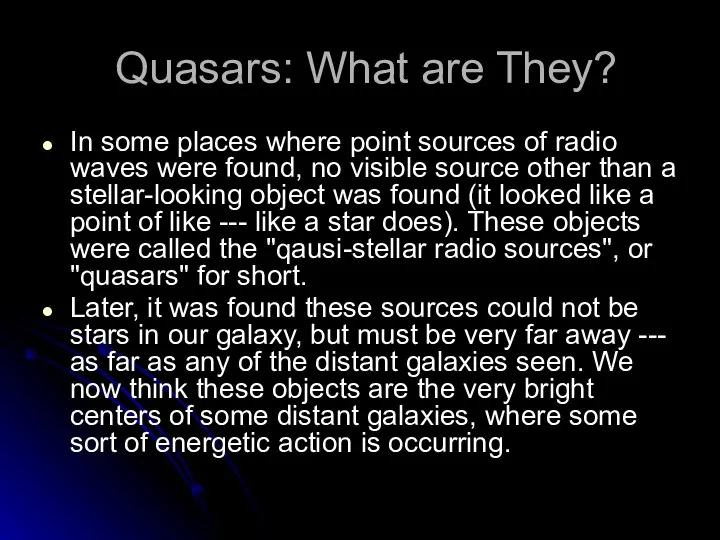
were found, no visible source other than a stellar-looking object was found (it looked like a point of like --- like a star does). These objects were called the "qausi-stellar radio sources", or "quasars" for short.
Later, it was found these sources could not be stars in our galaxy, but must be very far away --- as far as any of the distant galaxies seen. We now think these objects are the very bright centers of some distant galaxies, where some sort of energetic action is occurring.
Слайд 14Active Galactic Nuclei
In some galaxies, known as "active galactic nuclei" (AGN), the
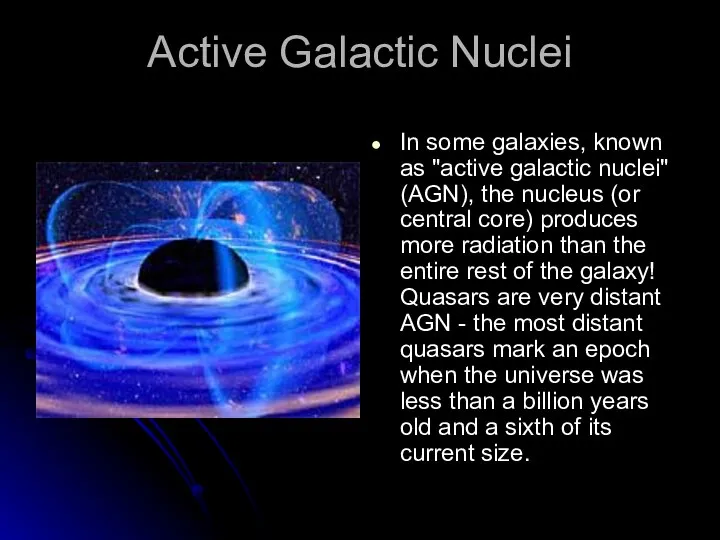
nucleus (or central core) produces more radiation than the entire rest of the galaxy! Quasars are very distant AGN - the most distant quasars mark an epoch when the universe was less than a billion years old and a sixth of its current size.
Слайд 15Brief Review of case for Super-Massive Black Holes in these observed AGN
The
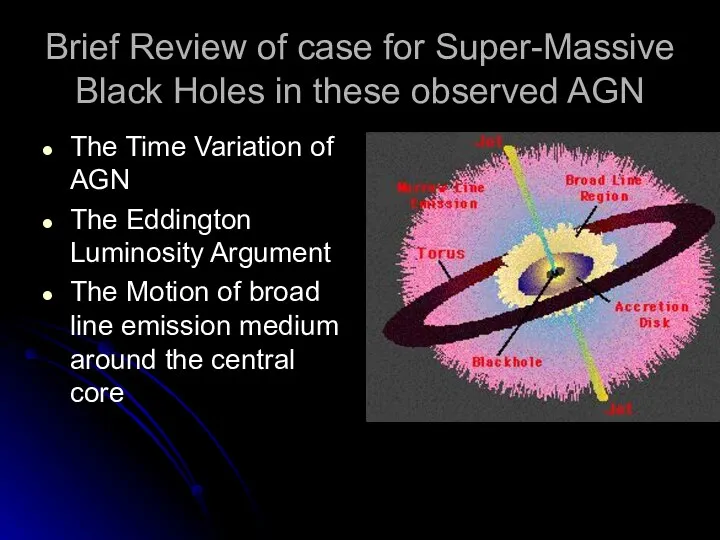
Time Variation of AGN
The Eddington Luminosity Argument
The Motion of broad line emission medium around the central core
Слайд 16How did Super-Massive Black Holes come about?--theories
From “Lumps” in the early universe
The
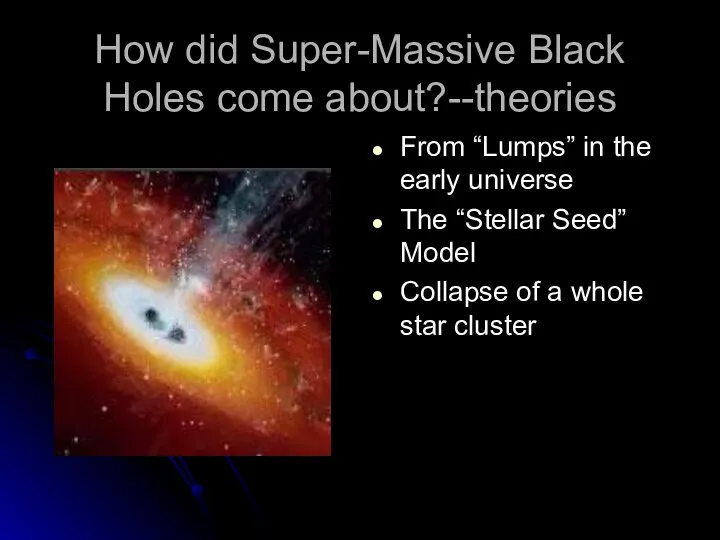
“Stellar Seed” Model
Collapse of a whole star cluster
Слайд 17Lumps from the early Universe
In the “Big Bang” the whole universe was
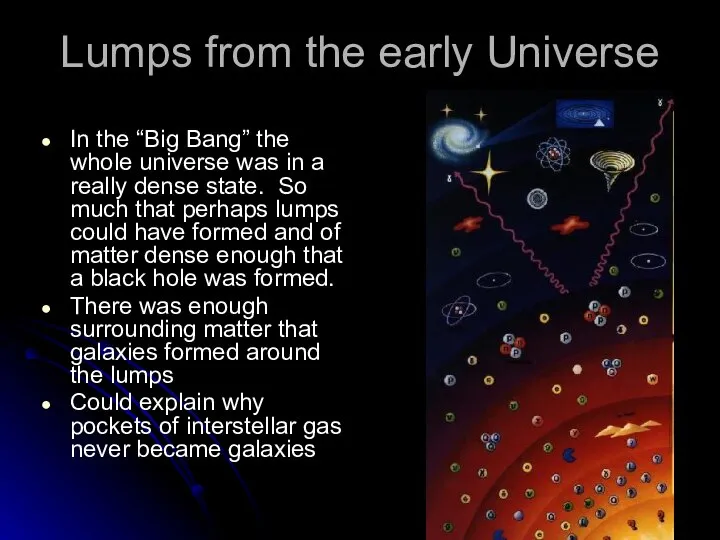
in a really dense state. So much that perhaps lumps could have formed and of matter dense enough that a black hole was formed.
There was enough surrounding matter that galaxies formed around the lumps
Could explain why pockets of interstellar gas never became galaxies
Слайд 18The Stellar Seed Model
Provided that the surrounding environment is sufficiently rich in
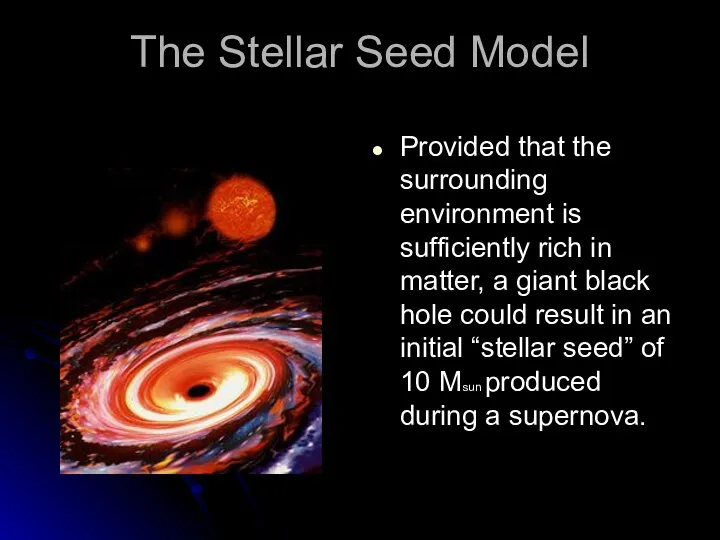
matter, a giant black hole could result in an initial “stellar seed” of 10 Msun produced during a supernova.
Слайд 19Collapse of a whole cluster
If the stars of a tight knit cluster
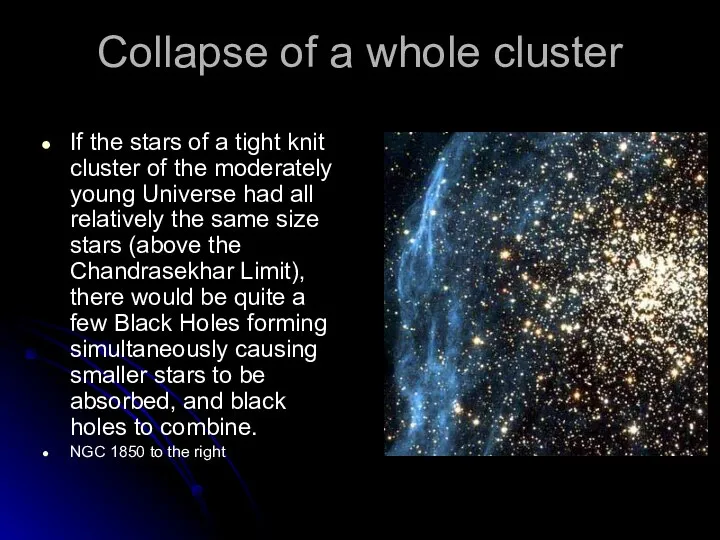
of the moderately young Universe had all relatively the same size stars (above the Chandrasekhar Limit), there would be quite a few Black Holes forming simultaneously causing smaller stars to be absorbed, and black holes to combine.
NGC 1850 to the right
Слайд 20Some Characteristic of AGN
Super Bright: AGN 3C273 (an extreme example) is L
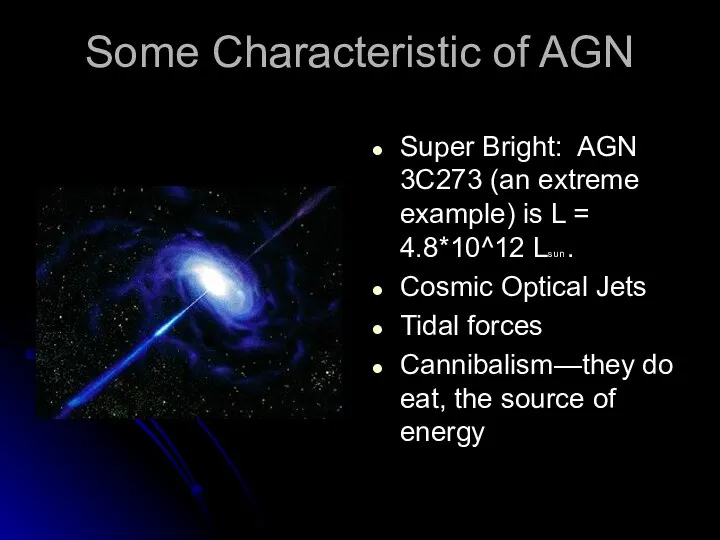
= 4.8*10^12 Lsun .
Cosmic Optical Jets
Tidal forces
Cannibalism—they do eat, the source of energy
Слайд 21Optical Jets—Why?
The magnetic fields around a black holes that are thought to
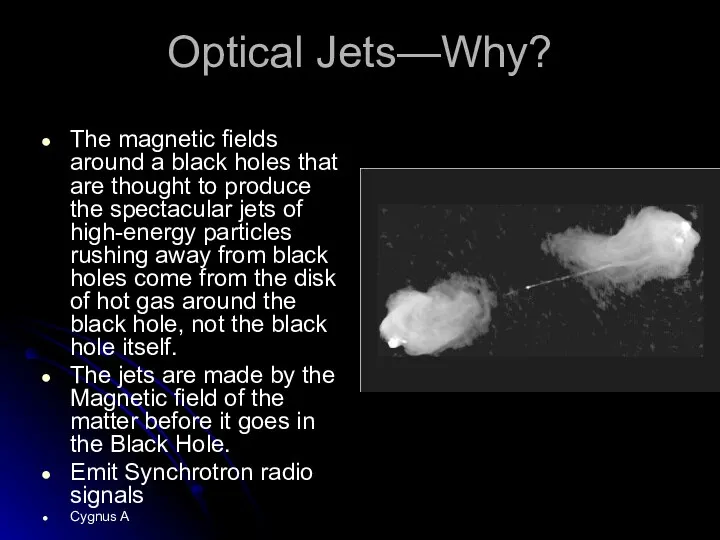
produce the spectacular jets of high-energy particles rushing away from black holes come from the disk of hot gas around the black hole, not the black hole itself.
The jets are made by the Magnetic field of the matter before it goes in the Black Hole.
Emit Synchrotron radio signals
Cygnus A
Слайд 22Tidal forces stretch farther, but are weaker
The tidal force is proportional to
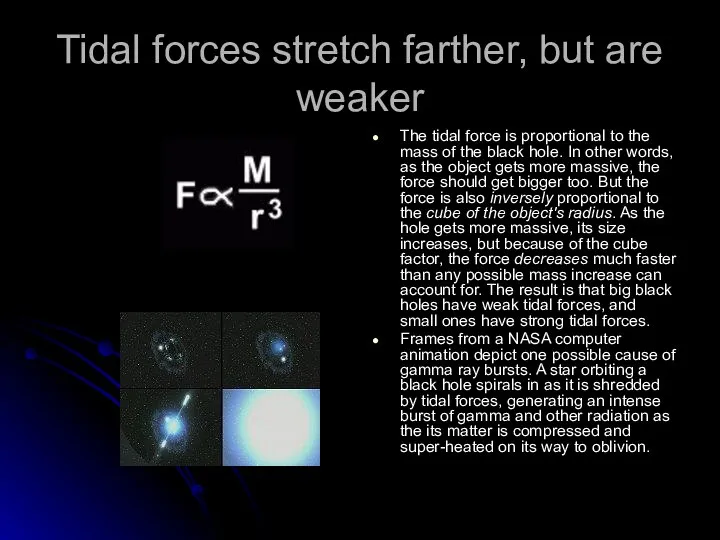
the mass of the black hole. In other words, as the object gets more massive, the force should get bigger too. But the force is also inversely proportional to the cube of the object's radius. As the hole gets more massive, its size increases, but because of the cube factor, the force decreases much faster than any possible mass increase can account for. The result is that big black holes have weak tidal forces, and small ones have strong tidal forces.
Frames from a NASA computer animation depict one possible cause of gamma ray bursts. A star orbiting a black hole spirals in as it is shredded by tidal forces, generating an intense burst of gamma and other radiation as the its matter is compressed and super-heated on its way to oblivion.
Слайд 23Cannibalism
Apparently, Quasars are only active on order of 100 million years
A dead
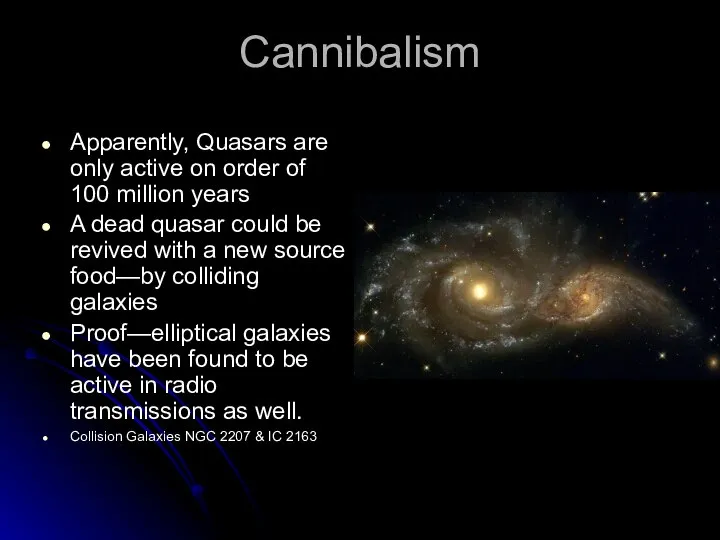
quasar could be revived with a new source food—by colliding galaxies
Proof—elliptical galaxies have been found to be active in radio transmissions as well.
Collision Galaxies NGC 2207 & IC 2163
Слайд 24Observations of Super Massive Black Holes
Radio observations at various radio telescopes
X-ray observations
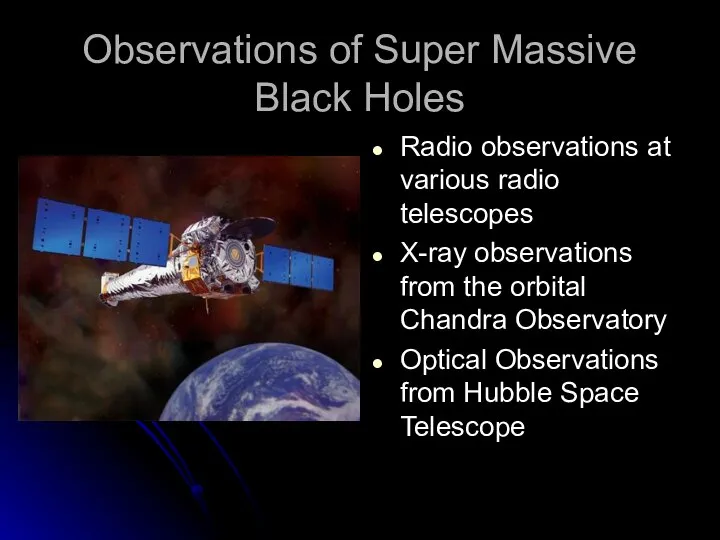
from the orbital Chandra Observatory
Optical Observations from Hubble Space Telescope
Слайд 26Fate of Universe?
All Black Holes Evaporate over time due to Hawking Radiation
Eventually
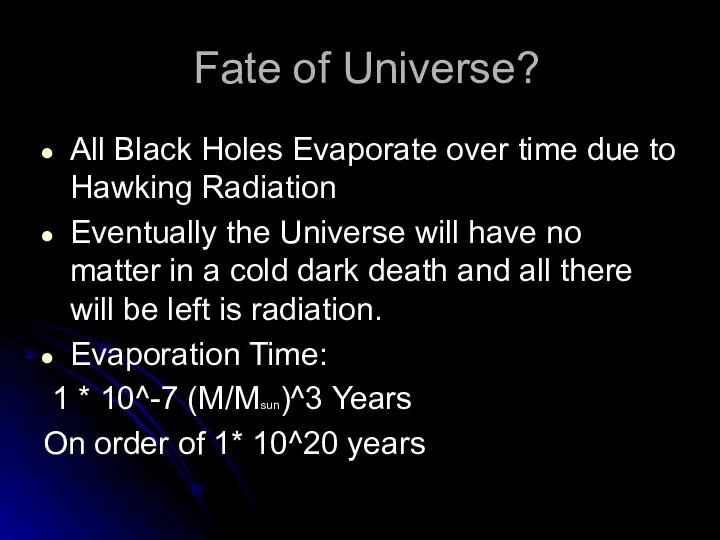
the Universe will have no matter in a cold dark death and all there will be left is radiation.
Evaporation Time:
1 * 10^-7 (M/Msun)^3 Years
On order of 1* 10^20 years























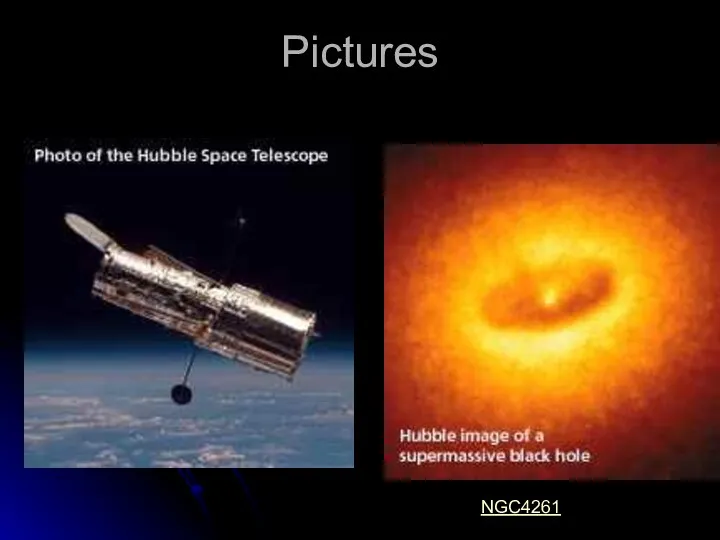

 Движущийся по небу поезд из спутников Илона Маска
Движущийся по небу поезд из спутников Илона Маска Лунное и солнечное затмение
Лунное и солнечное затмение День космонавтики
День космонавтики Космонавты и их достижения
Космонавты и их достижения Загадки тунгусского метеорита
Загадки тунгусского метеорита Астероиды и информационные технологии
Астероиды и информационные технологии Состав и строение Солнца
Состав и строение Солнца Наука астрономия
Наука астрономия Триумф 65/5. Юпитер
Триумф 65/5. Юпитер Презентация на тему Николай Коперник. Теория действительности
Презентация на тему Николай Коперник. Теория действительности  День космонавтики
День космонавтики 12 апреля День Космонавтики
12 апреля День Космонавтики Определение расстояний и размеров тел в солнечной системе
Определение расстояний и размеров тел в солнечной системе Безбрежный космос
Безбрежный космос Первый региональный космический марафона Наследники первых. Флешмоб Наследники первых (индивидуальная номинация)
Первый региональный космический марафона Наследники первых. Флешмоб Наследники первых (индивидуальная номинация) Звёзды и созвездия
Звёзды и созвездия Человек шагнул в космос 6 класс
Человек шагнул в космос 6 класс Космические аппараты
Космические аппараты Большие астероиды и их движение
Большие астероиды и их движение Общие теоретические основы управления техническими системами. Тема 1
Общие теоретические основы управления техническими системами. Тема 1 Эволюция Солнечной Системы
Эволюция Солнечной Системы Эволюция звёзд
Эволюция звёзд d314ec8870d14e6a890932307846feb7
d314ec8870d14e6a890932307846feb7 История открытия Плутона
История открытия Плутона Сергей Рязанский
Сергей Рязанский Космос и планеты. 8 класс
Космос и планеты. 8 класс Точки и линии небесной сферы
Точки и линии небесной сферы Современное освоение планеты
Современное освоение планеты